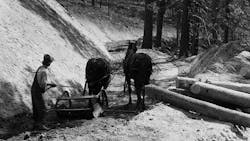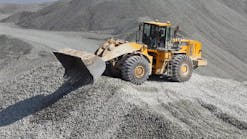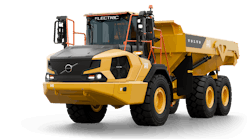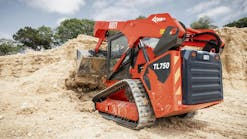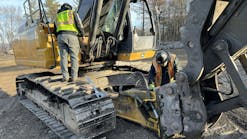This one goes out to all the Operating Engineers who complain about comfort seats being too soft, electronic controls being mushy, or the climate control not working right.
The Historical Construction Equipment Association preserves the history of the construction, dredging, and surface mining industries. But what about when equipment use was minimal, especially well after so much of the work was mechanized?
Yellow Pine is a settlement of 32 people (2010 Census) in eastern Valley County, central Idaho. It’s situated 4,765 feet above sea level on the East Fork of the South Fork of the Salmon River, about half a mile upstream from the mouth of Johnson Creek. Knox, 30 miles to the south-southwest, is now a ghost town; a mile north of Warm Lake, it once had a population of 200 and served as a supply station for area miners.
These images show the construction of the Knox-Yellow Pine road. Now identified as two National Forest (NF) Development Roads, it is NF 413 up Johnson Creek to Trout Creek, thence NF 467 up Trout Creek, over a divide at 7,200 foot elevation and then down 2,000 feet through a pasture named Hard Knox to Knox.
It’s worth noting that these images were taken 101 years ago, in the summer of 1923. Other than the remoteness of the project, no explanation is available for the use of 100% manual labor and animal power this long after the advent of full-revolving shovels and mechanical haulage by truck or narrow-gauge train.
About the HCEA
The Historical Construction Equipment Association (HCEA) is a 501(c )3 nonprofit organization dedicated to preserving the history of the construction, dredging and surface mining equipment industries. With over 3,500 members in a dozen countries, our activities include operation of National Construction Equipment Museum and archives in Bowling Green, Ohio; publication of a quarterly magazine, Equipment Echoes, from which this text is adapted, and hosting an annual working exhibition of restored construction equipment. Individual annual memberships are $45 within the U.S. and Canada, and $65 elsewhere. Our next International Convention and Old Equipment Exposition will be August 7-10, 2024, in Canandaigua, New York. We seek to develop relationships in the equipment manufacturing industry, and we offer a college scholarship for engineering students. Information is available at www.hcea.net, or by calling 419.352.5616 or e-mailing [email protected].
